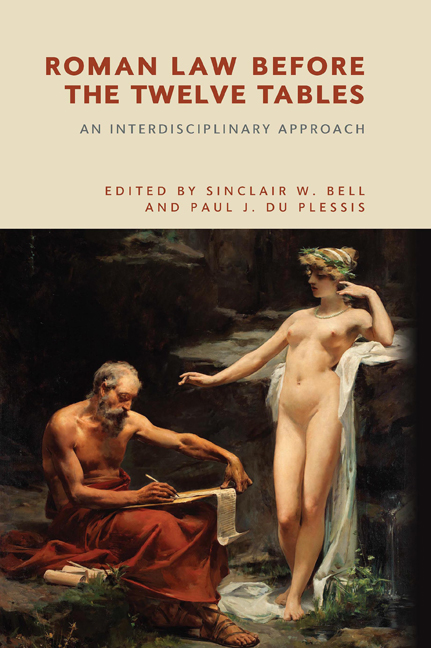Book contents
- Frontmatter
- Contents
- The Contributors
- Introduction: The Dawn of Roman Law
- Part I The Materiality of Roman Law: New Archaeological Discoveries
- 1 Roman Law in its Italic Context
- 2 Central Italian Elite Groups as Aristocratic Houses in the Ninth to Sixth Centuries BCE
- 3 Authority and Display in Sixth-Century Etruria: The Vicchio Stele
- Part II Constructing Early Roman Law: Sources and Methods
- 4 The Twelve Tables and the leges regiae: A Problem of Validity
- 5 The leges regiae in Livy: Narratological and Stylistic Strategies
- 6 The leges regiae through Tradition, Historicity and Invention: A Comparison of Historico-literary and Jurisprudential Sources
- 7 The Laws of the Kings – A View from a Distance
- 8 Beyond the Pomerium: Expansion and Legislative Authority in Archaic Rome
- Part III Roman Law in Historiography and Theory
- 9 Niebuhr and Bachofen: New Forms of Evidence on Roman History
- 10 Finding Melanesia in Ancient Rome: Mauss’ Anthropology of nexum
- Index
2 - Central Italian Elite Groups as Aristocratic Houses in the Ninth to Sixth Centuries BCE
Published online by Cambridge University Press: 22 September 2020
- Frontmatter
- Contents
- The Contributors
- Introduction: The Dawn of Roman Law
- Part I The Materiality of Roman Law: New Archaeological Discoveries
- 1 Roman Law in its Italic Context
- 2 Central Italian Elite Groups as Aristocratic Houses in the Ninth to Sixth Centuries BCE
- 3 Authority and Display in Sixth-Century Etruria: The Vicchio Stele
- Part II Constructing Early Roman Law: Sources and Methods
- 4 The Twelve Tables and the leges regiae: A Problem of Validity
- 5 The leges regiae in Livy: Narratological and Stylistic Strategies
- 6 The leges regiae through Tradition, Historicity and Invention: A Comparison of Historico-literary and Jurisprudential Sources
- 7 The Laws of the Kings – A View from a Distance
- 8 Beyond the Pomerium: Expansion and Legislative Authority in Archaic Rome
- Part III Roman Law in Historiography and Theory
- 9 Niebuhr and Bachofen: New Forms of Evidence on Roman History
- 10 Finding Melanesia in Ancient Rome: Mauss’ Anthropology of nexum
- Index
Summary
INTRODUCTION
Early Roman laws like those expressed in the Twelve Tables did not come forth ex novo in the middle of the fifth century BCE; instead, it is far more likely that they formalised and regulated customary practices that had already been accruing for decades, if not centuries. Arguably, this process was intertwined with the emergence of urbanisation and state organisation at the sites that would later become the major cities of the western coast of central Italy. Investigating the groups who established these settlements and their customary interactions with one another can therefore prove beneficial for understanding how and why early Roman law developed the way it did. Due to the lack of surviving literary sources from this period (the ninth to sixth centuries BCE generally), evidence must largely be derived from the realm of archaeology.
Although a significant amount of good-quality new archaeological data is now available for most of Italy, it is not intrinsically suited to proving that specific events did or did not happen; rather, it can lend itself, when adequately handled, to the kind of broad structural treatments that can clarify important connections and the deep workings of the forces involved in these processes. Unfortunately, archaeological data has been used sparingly when attempting to understand the origins and development of social groups on the Italian peninsula, with the debate instead centred on the impact of generalised internal and external triggers to urbanisation. For studies of this period to move forward, new heuristic models must be utilised that are able to bring together and take advantage of all types of available evidence, whether textual, epigraphic, or archaeological. As a further benefit, such an approach would reconnect early Rome and Latium with recent developments in the larger discipline of social and state formation studies around the world, offering the opportunity for a greater amount of cross-cultural comparison and hypothesis formulation beyond the standard problematic comparison with the Greek genos.
Archaeological discoveries in the last few decades have driven a re-evaluation of the social and state formation processes taking place in central Italy during the transition to urban life in the late Iron Age by offering an alternative to the endless dissection of historians like Livy and Dionysius of Halicarnassus.
- Type
- Chapter
- Information
- Roman Law before the Twelve TablesAn Interdisciplinary Approach, pp. 25 - 40Publisher: Edinburgh University PressPrint publication year: 2020



